Complete Solutions to Single Correct of chapter CALORIMETRY of Class 11 book with complete answers and questions
| Class 11 | PHYSICS |
| Chapter | CALORIMETRY |
| CENGAGE PHYSICS | Single Correct |
| Number Of Questions | 100 |
| Academic Year | 2023-24 |
The design of some physical instrument requires that there be a constant difference in length of 10 cm between an iron rod and a copper cylinder laid side by side at all temperatures. Find their lengths.
`(alpha_(Fe)=11 xx 10^(6).^(@)C^(-1),alpha_(Cu)=17 xx 10^(-6) .^(@)C^(-1))`
View SolutionAn isosceles triangles is formed with a thin rod of length `l_(1)` and coefficient of linear expansion `alpha_(1)`, as the base and two thin rods each of length `l_(2)` and coefficient of linear expansion `alpha_(2)` as the two sides. The distance between the apex and the midpoint of the base remain unchanged as the temperature is varied. The ratio of lengths `(l_(1))/(l_(2))` is
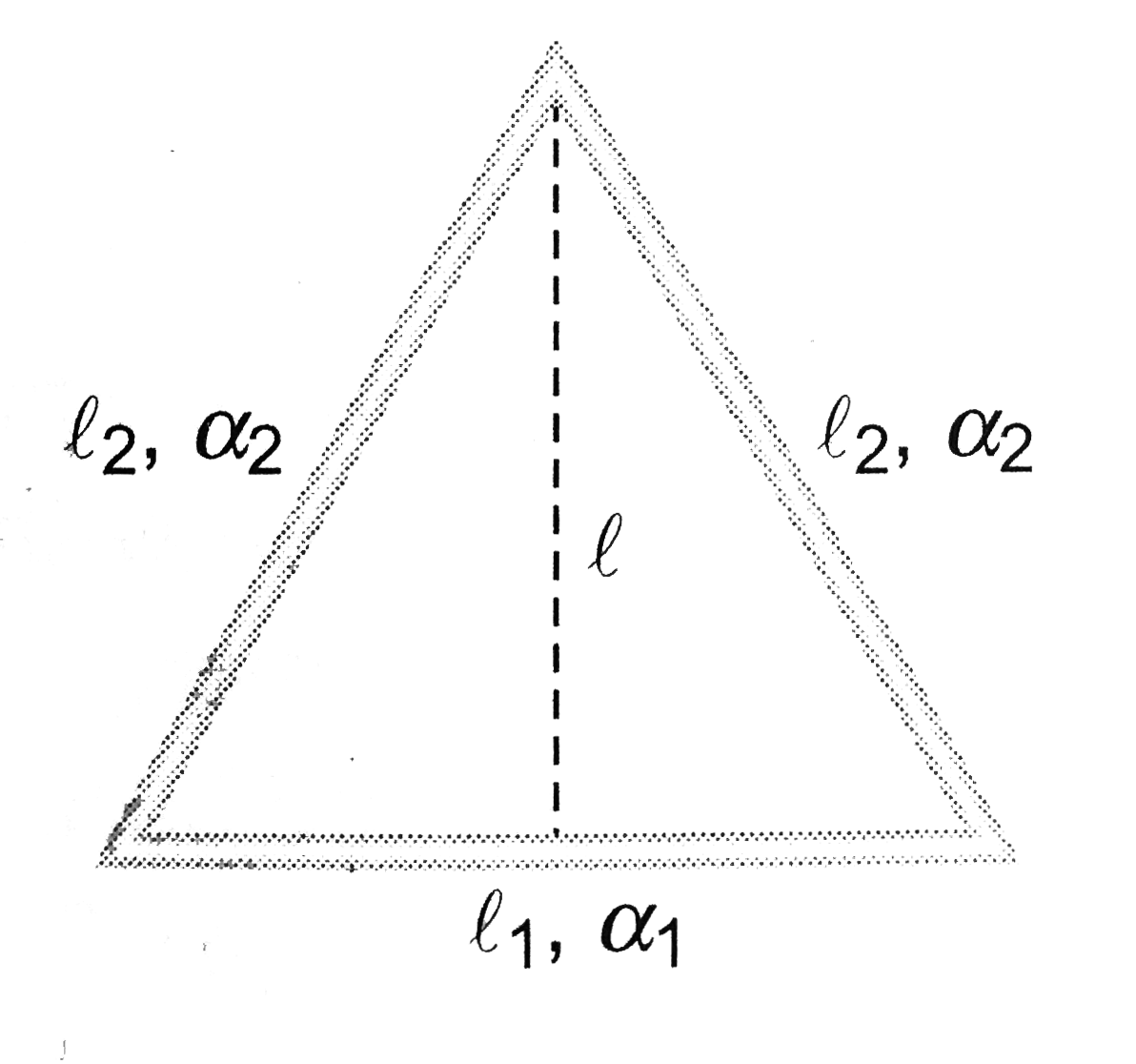
View SolutionAn iron rod of length 50 cm is joined at an end to aluminium rod of length 100 cm. All measurements refer to 20_0 C . Find the length of the composite system at 100`0` C. and its average coefficent of linear expansion. The coefficient o f linear expansion o f iron and aluminium are 10 xx 10_-6 0 C_-1 and 24 xx10_-6 0 C _-1 respectively.
View SolutionA brass rod and a lead rod each 80 cm long at `0^@C` are clamped together at one end with their free ends coinciding. The separatioin of free ends of the rods if the system is placed in a steam bath is (`alpha_("brass")=18xx10^(-6)//^(@)C` and `alpha_("lead")=28xx10^(-6)//^(@)C`)
View SolutionThe coefficient of apparent expansion of a liquid in a copper vessel is C and in a silver vessel S. The coefficient of volume expansion of copper is `gamma_C`. What is the coefficient of linear expansion of silver
View SolutionA uniform solid brass sphere is rotating with angular speed `omega_0` about a diameter. If its temperature is now increased by `100^@C`, what will be its new angular speed. (given`alpha_B=2.0xx10^-5per^@C`)
View SolutionThe absolute coefficient of expansion of a liquid is 7 times that the volume coefficient of expansion of the vessel. Then the ratio of absolute and apparent expansion of the liquid is
View SolutionA solid whose volume does not change with temperature floats in a liquid. For two different temperatures `t_1` and `t_2` of the liqiud, fraction `f_1` and `f_2` of the volume of the solid remain submerged in the liquid. The coefficient of volume expansion of the liquid is equal to
View SolutionA long metal rod is bent to form a ring with a small gap if this is heated, will this gap increase or decrease?
View SolutionTwo large holes are cut in a metal sheet. If this is heated, will their diameters increase or decrease?
View SolutionAn iron tyre is to be fitted onto a wooden wheel 1.0 m in diameter. The diameter of the tyre is 6 mm smaller than that of wheel the tyre should be heated so that its temperature increases by a minimum of (coefficient of volume expansion of iron is `3.6xx10^-5//^@C`)
View SolutionA clock with a metallic pendulum gains 5 s each day at a temperature of `15^@C` and loses 10 s each day at a temperature of `30^@C`. Find the coefficient of thermal expansion of the pendulum metal.
View SolutionA wire of length `L_0` is supplied heat to raise its temperature by T. if `gamma` is the coefficient of volume expansion of the wire and Y is Young's modulus of the wire then the energy density stored in the wire is
View Solution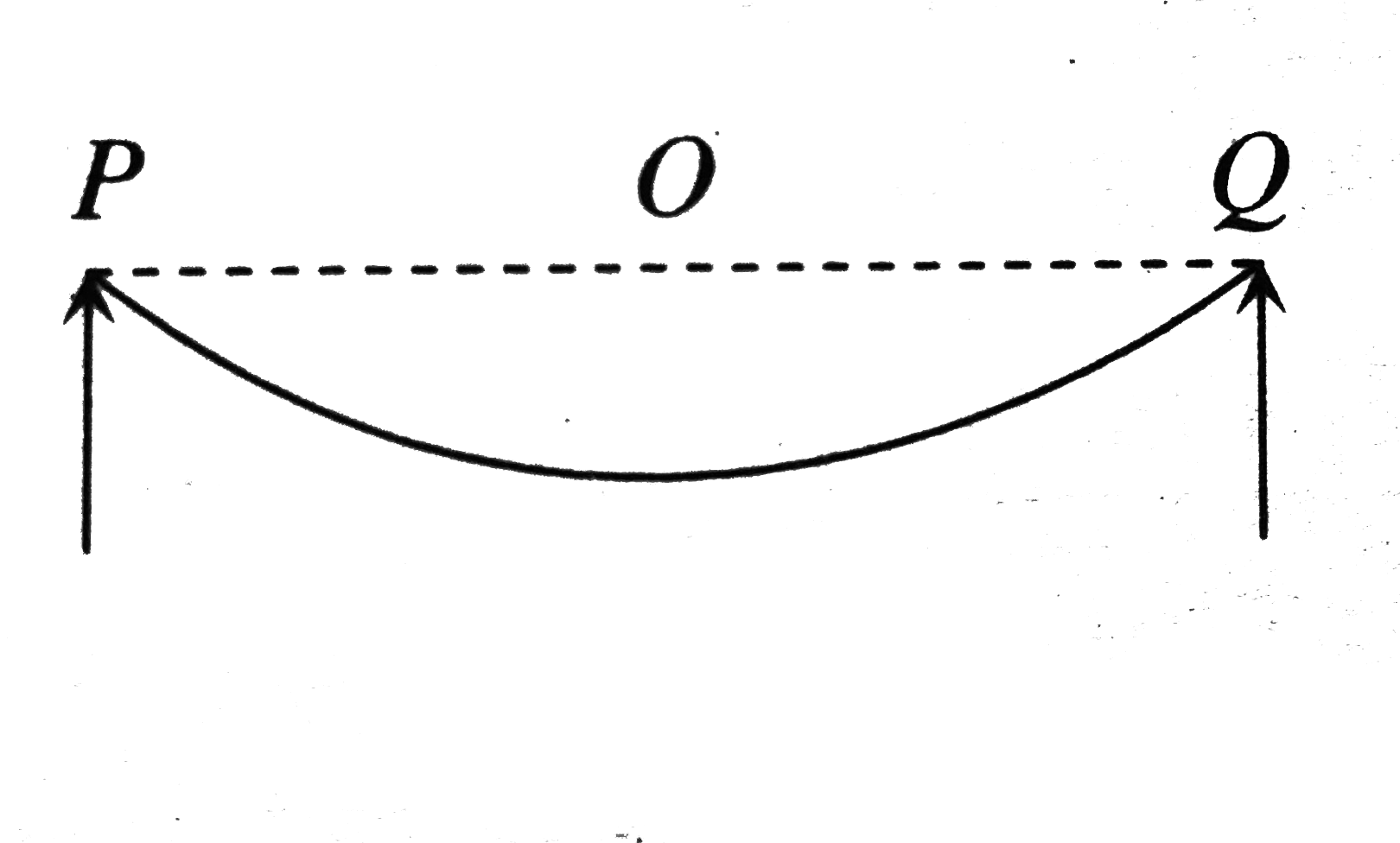
Span of bridge is 2.4 km. At `30^@C` a cable along the span sags by 0.5 km. Taking `alpha=12xx10^(-6)//^@C`, change in length of cable for a change in temperature from `10^@C` to `42^@C` is
View SolutionThe specific heat of a substance varies with temperature `t(.^(@)C)` as
`c=0.20+0.14t+0.023t^2 (cal//g^(@)//C)`
The heat required to raise the temperature of 2 g of substance from `5^@C` to `15^@C` will be
View SolutionWork done in converting 1 g of ice at `-10^@C` into steam at `100^@C` is
View Solution50 g of copper is heated to increase its temperature by `10^@C`. If the same quantity of heat is given to `10g` of water, the rise in its temperature is (specific heat of copper`=420J//kg^(@)//C`)
View SolutionTwo liquid A and B are at `32^@C` and `24^@C`. When mixed in equal masses the temperature of the mixture is found to be `28^@C`. Their specific heats are in the ratio of
View SolutionA beaker contains 200 g of water. The heat capacity of the beaker is equal to that of 20 g of water. The initial temperature of water in the beaker is `20^@C` .If 440 g of hot water at `92^@C` is poured in it, the final temperature (neglecting radiation loss) will be nearest to
View SolutionA liquid of mass m and specific heat c is heated to a temperature 2T. Another liquid of mass m/2 and specific heat 2 c is heated to a temperature T. If these two liquids are mixed, the resulting temperature of the mixture is
View SolutionThree liquids with masses `m_1`,`m_2`,`m_3` are throughly mixed. If their specific heats are `c_1`,`c_2`,`c_3` and their temperature `T_1`,`T_2`,`T_3`, respectively, then the temperature of the mixture is
View SolutionIn an industrial process 10 kg of water per hour is to be heated from `20^@C` to `80^@C`. To do this steam at `150^@C` is passed from a boiler into a copper coil immersed in water. The steam condenses in the coil and is returned to the boiler as water at `90^@C`. How many kilograms of steam is required per hour (specific heat of steam`=1 cal//g^@C`, Latent heat of vapourization`=540 cal//g`)?
View SolutionA calorimeter contains 0.2 kg of water at `30^@C`. 0.1 kg of water at `60^@C` is added to it, the mixture is well stirred and the resulting temperature if found to be `35^@C`. The thermal capacity of the calorimeter is
View SolutionConsider two rods of same length and different specific heats (`S_1` and `S_2`), conductivities `K_1` and `K_2` and area of cross section (`A_1` and `A_2`) and both having temperature `T_1` and `T_2` at their ends. If the rate of heat loss due to conduction is equal then
View SolutionA semicircular rods is joined at its end to a straight rod of the same material and the same cross-sectional area. The straight rod forms a diameter of the other rod. The junctions are maintained at different temperatures. Find the ratio of the heat transferred through a cross section of the semicircular rod to the heat transferred through a crossection of the straight rod in a given time.
View SolutionA heat flux of 4000 J/s is to be passed through a copper rod of length 10 cm and area of cross section `100cm^2`. The thermal conductivity of copper is `400W//m//^(@)C` The two ends of this rod must be kept at a temperature difference of
View SolutionThe coefficient of thermal conductivity of copper, mercury and glass are respectively `K_(c), K_(m)` and `K_(g)` that `K_(c) gt K_(m) gt K_(g)`. If the same quantity of heat is to flow per second per unit of each and corresponding temperature gradients are `X_(c), X_(m)` and `X_(g)`, then
View SolutionA point source of heat of power P is placed at the centre of a spherical shell of mean radius R. The material of the shell has thermal conductivity K. If the temperature difference between the outer and inner surface of the shell in not to exceed T, the thickness of the shell should not be less than .......
View SolutionThere are three thermometers one in contact with the skin of the man other in between the vest and the shirt and third in between the shirt and coat. The readings of the thermometers are `30^@C`,`25^@C` and `22^@C`, respectively. If the vest and the shirt are of the same thickness, the ratio of their thermal conductivities is
View SolutionTwo rods are of same material and having same length and area. If heat `DeltaQ` flows through them for 12 min when they are joined side by side. If now both the rods are joined in parallel, then the same amount of heat `DeltaQ` will flow in
View Solution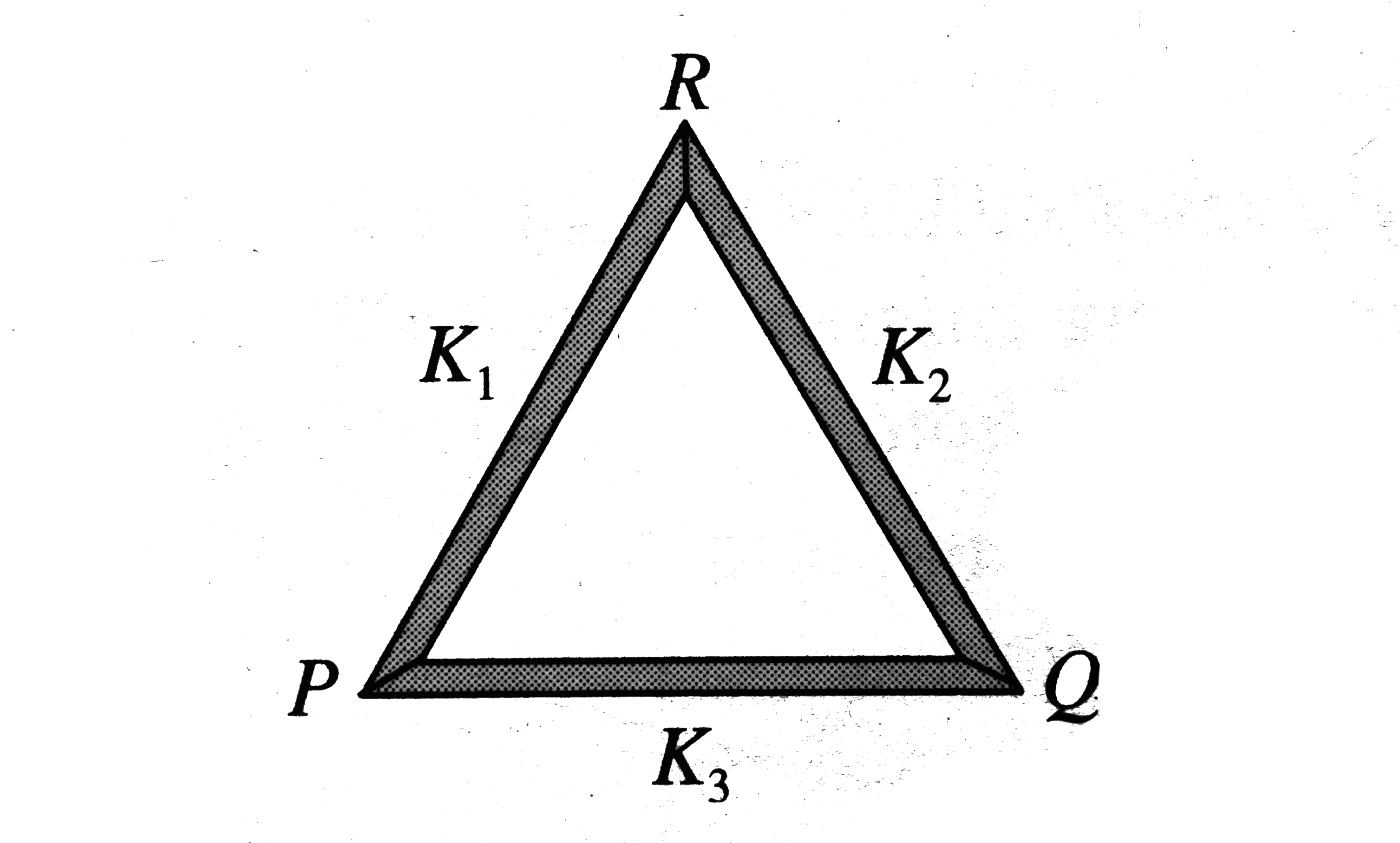
Three rods of same dimensions are arranged as shown in Fig. They have thermal conductivities `K_1`,`K_2` and `K_3`. The points P and Q are maintained at different temeperature for the heat to flow at the same rate along PRQ and PQ. Whi of the following options correct?
View Solution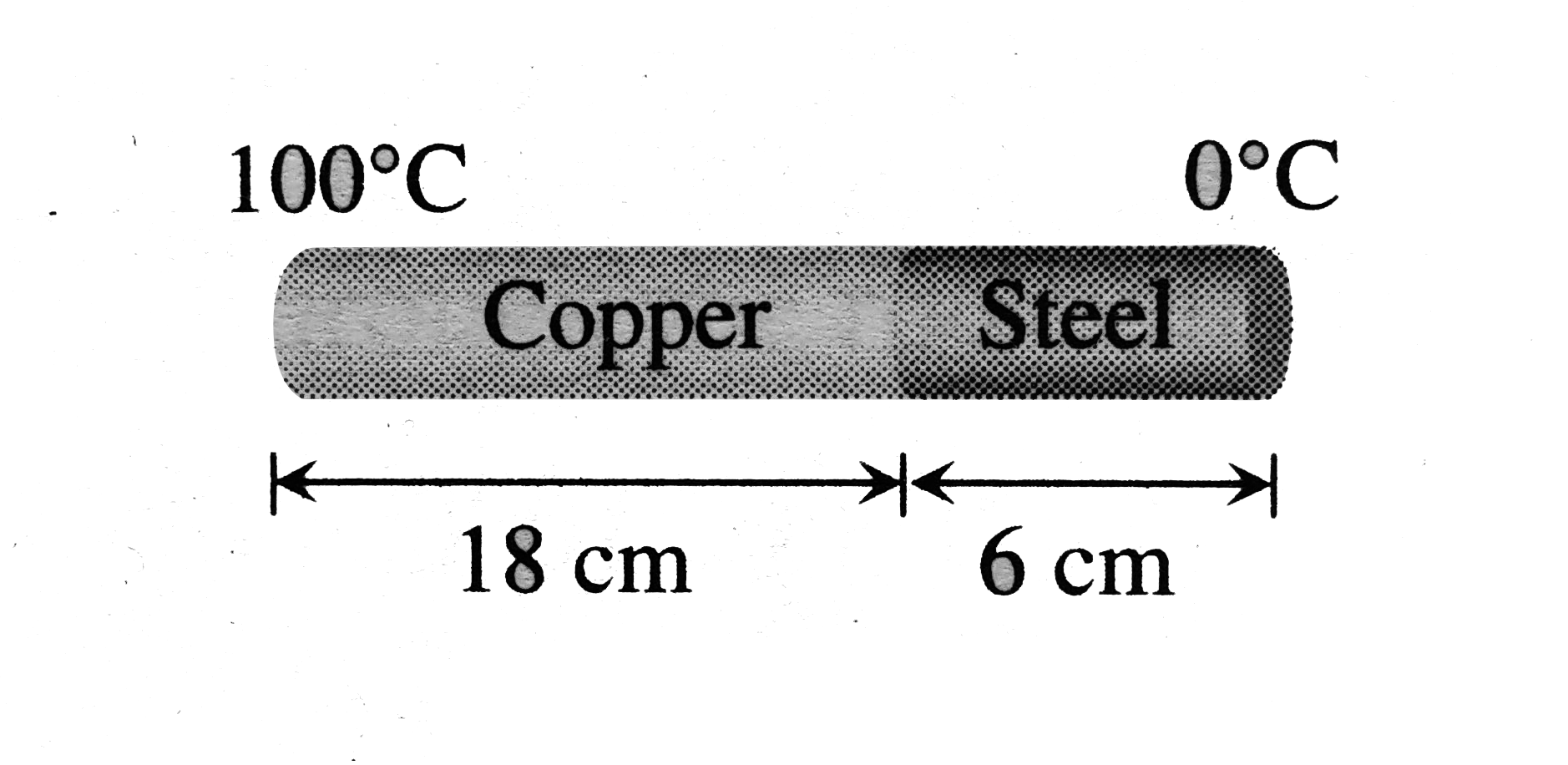
The coefficient of thermal conductivity of copper is nine times that of steel. In the composite cylindrical bar shown in Fig. what will be the temperature at the junction of copper and steel ?
View Solution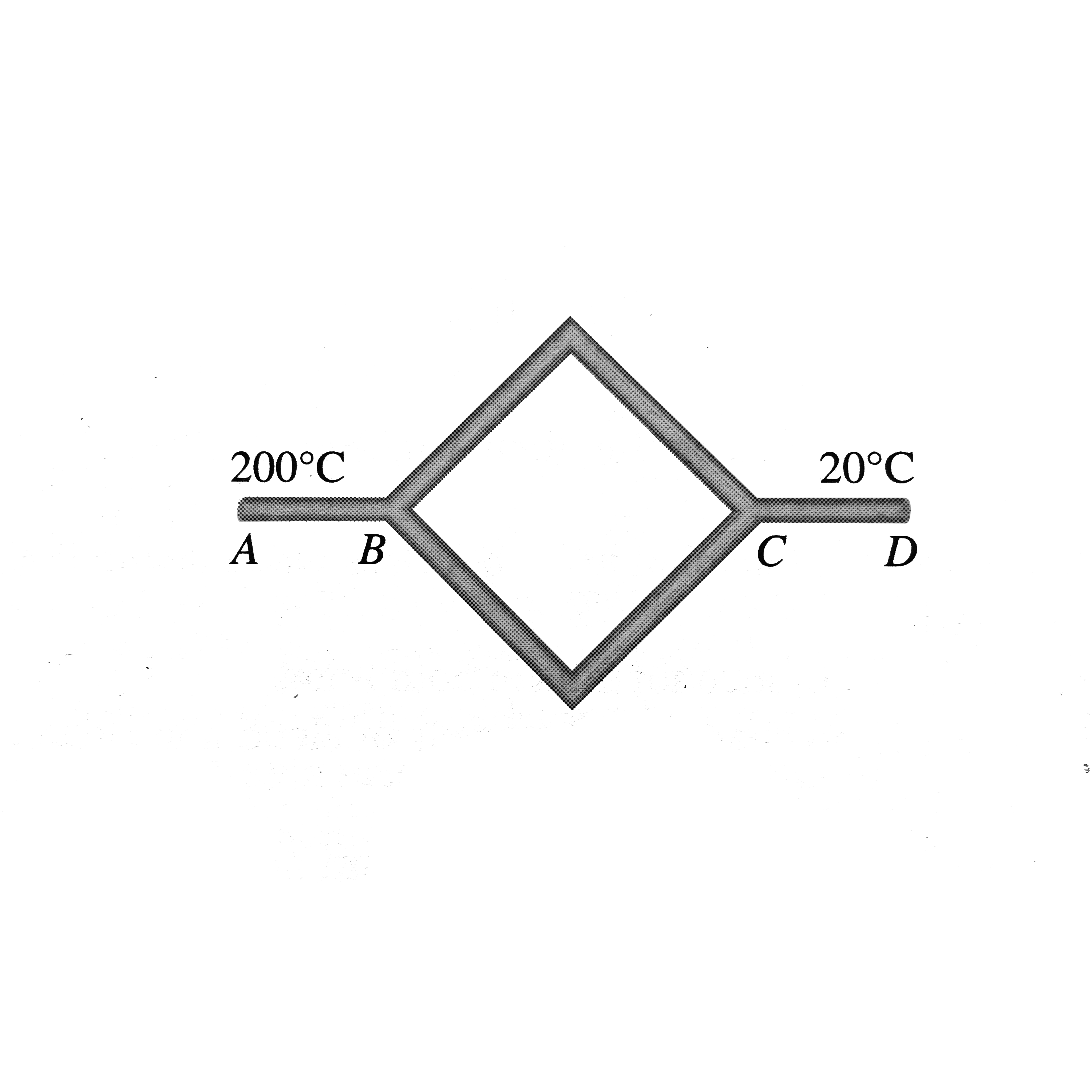
Six identical cunducting rods are joined as shown in Fig. Points A and D are maintained at temperatures `200^@C` and `20^@C` respectively. The temperature of junction B will be
View SolutionAn ice box used for keeping eatables cool has a total wall area of `1m^2` and a wall thickness of 5.0 cm. The thermal conductivity of the ice box is `K=0.01 J//m^@C`. It is filled with large amount of ice at `0^@C` along with eatables on a day when the temperature is `30^@C` The latent heat of fusion of ice is `334xx10^3 J//kg`. The amount of ice melted in one day is ( 1 day`=86,000s`)
View Solution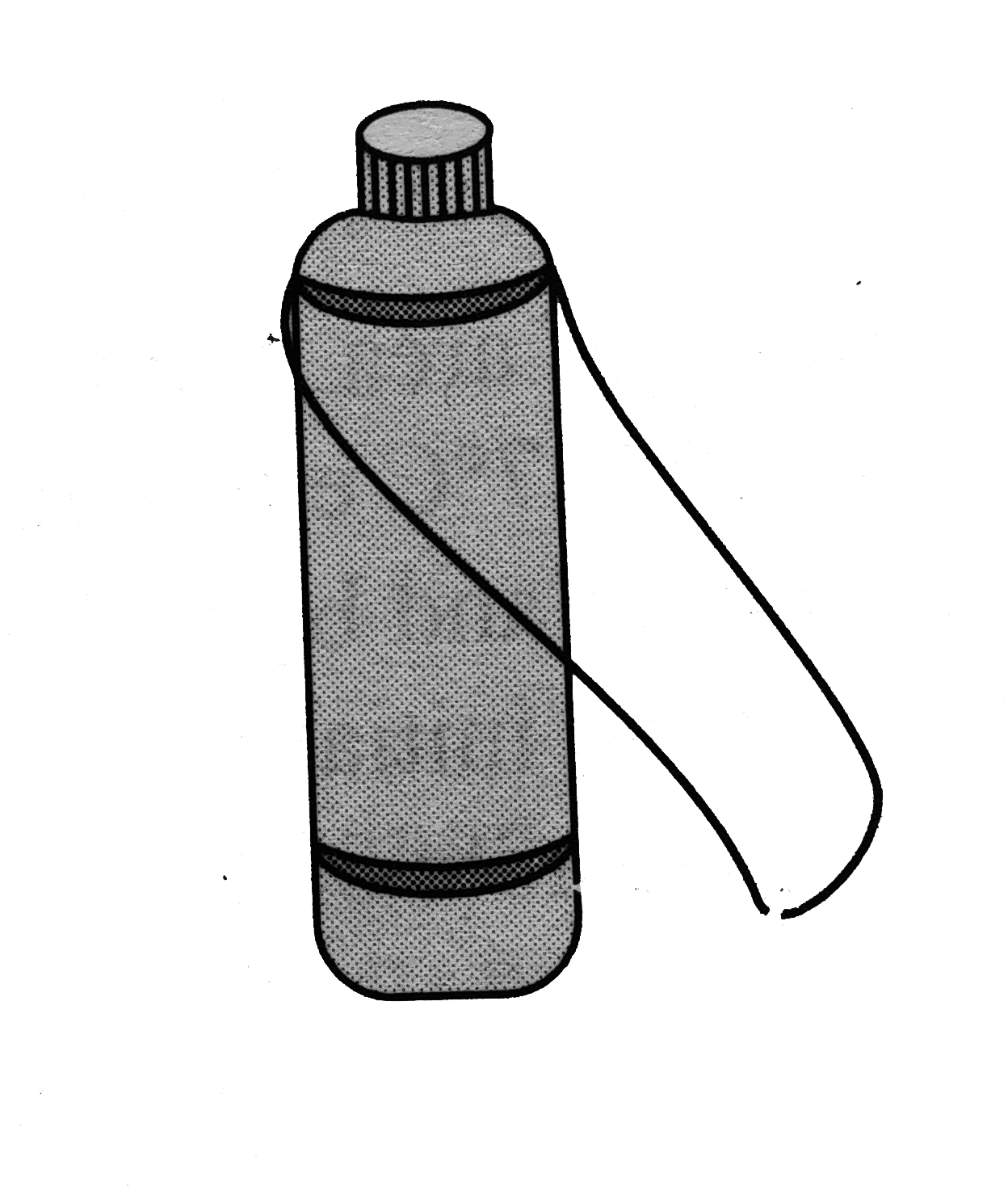
The only possibility of heat flow in a thermos flask is through its cork which is `75cm^2` in area and 5 cm thick its thermal conductivity is `0.0075 cal//cm-s-^@C`. The outside temperature is `40^@C` and latent heat of ice is `80 cal//g`. Time taken by 500 g of ice at `0^@C` in the flask to melt into water at `0^@C` is `
View SolutionCertain substance emits only the wavelengths `lamda_1,lamda_2,lamda_3` and `lamda_4` when it is at a high temperature, it will absorb only the following wavelengths
View Solution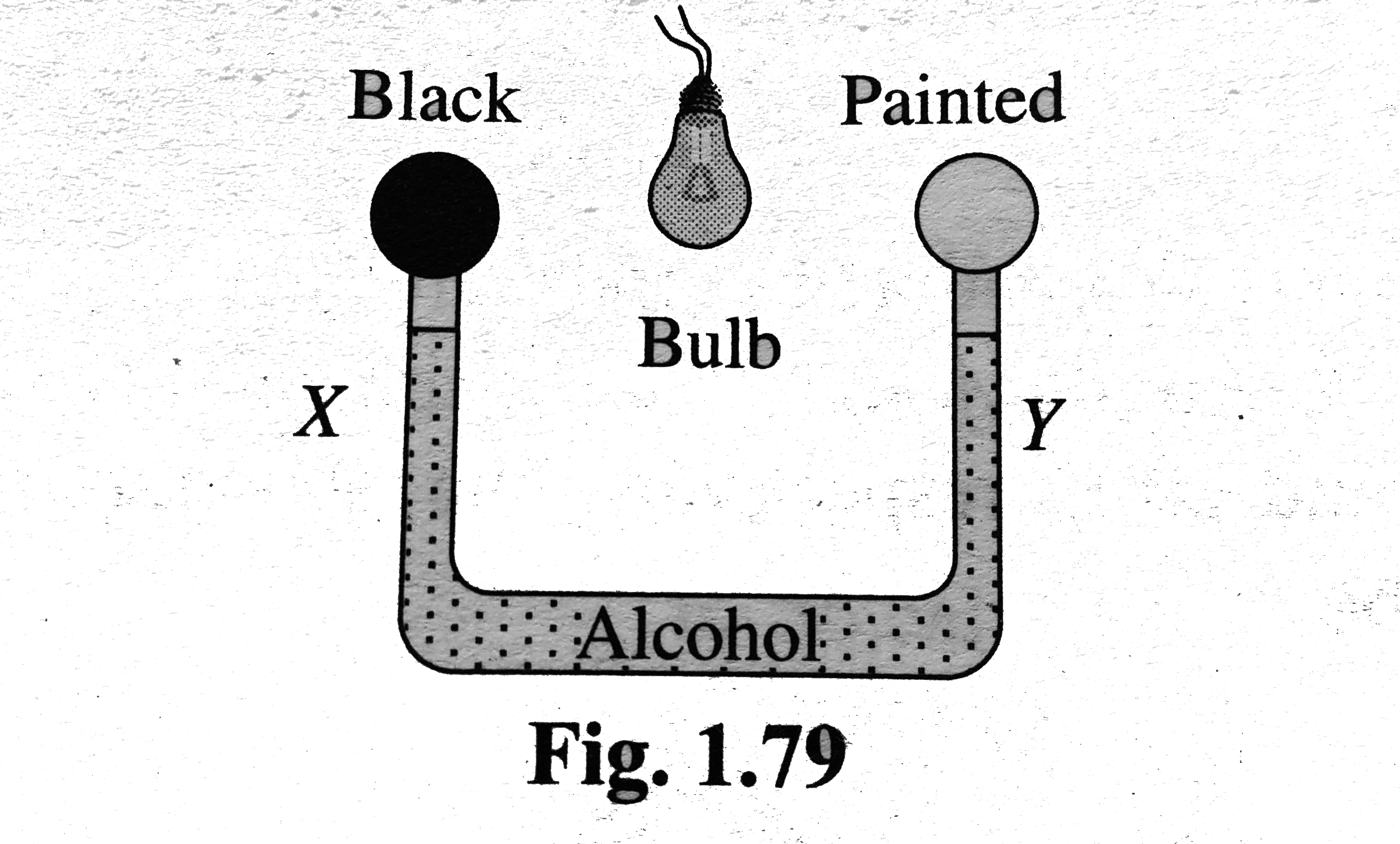
Figure. Shows two air filled bulbs connected by a U-tube partly filled with alcohol. What happens to the levels of alcohol in the limbs X and Y when an electric bulb placed midway between the bulbs is lighted?
View SolutionA black body at 200 K is found to emit maximum energy at a wavelength of `14mu m`. When its temperature is raised to 1000 K, the wavelength at which maximum energy is emitted is
View SolutionThe energy spectrum f a black body exhibits a maximum around a wavelength `lamda_0`. The temperature of the black body is now changed such that the energy is maximum around a wavelength `3 lamda_0//4`. The power radiated by the black body will now increase by a factor of
View SolutionThe wavelength of maximum energy released during an atomic axplosion was `2.93xx10^(-10)m`. Given that Wien's constant is `2.93xx10^(-3)m-K`, the maximum temperature attained must be of the order of
View SolutionThe rectangular surface of area `8 cm xx 4 cm` of a black body at temperature `127^(@)C` emits energy `E` per section if length and breadth are reduced to half of the initial value and the temperature is raised to `327^(@)C`, the ratio of emission of energy becomes
View SolutionA solid copper cube of edges 1 cm is suspended in an evacuated enclosure. Its temperature is found to fall from `100^@C` to `99^@C` in 100 s. Another solid copper cube of edges 2 cm, with similar surface nature, is suspended in a similar manner. The time required for this cube to cool from `100^@C` to `99^@C` will be approximately
View SolutionA sphere, a cube and a thin circular pate are heated to the same temperature. If they are made of same material and have equal masses, determine which of these three object cools the fastest and which one cools the slowest?
View SolutionA sphere and a cube of same material and same volume are heated up to same temperature and allowed to cool in the same sorroundings. The radio of the amounts of radiations emitted in equal time intervals will be
View SolutionA substance cools from `75^@C` to` 70^@C` in `T_1` minute, from `70^@C` to `65^@C` in `T_2` minute and from `65^@C` to `60^@C` in `T_3` minute, then.
View SolutionA liquid takes 5 minutes to cool from `80^@C` to` 50^@C` . How much time will it take to cool from `60^@C` to `30^@C`? The temperature of surroundings is `20^@C`.
View SolutionA body takes T minutes to cool from `62^@C` to `61^@C` when the surrounding temperature is `30^@C`. The time taken by the body to cool from `46^@C` to `45^@C` is
View SolutionThe rates of cooling of two different liquids put in exactly similar calorimeters and kept in identical surroundings are the same if
View SolutionHot water cools from `60^@C` to `50^@C` in the first 10 min and to `42^@C` in the next 10 min. The temperature of the surrounding is
View SolutionThere are two thin spheres A and B of the same material and same thickness. They behave like black bodies, Radius of A is double that of B and Both have same temperature T. When A and B are kept in a room of temperature `T_0 (lt T)`, the ratio of their rates of cooling is (assume negligible heat exchange between A and B).
View Solution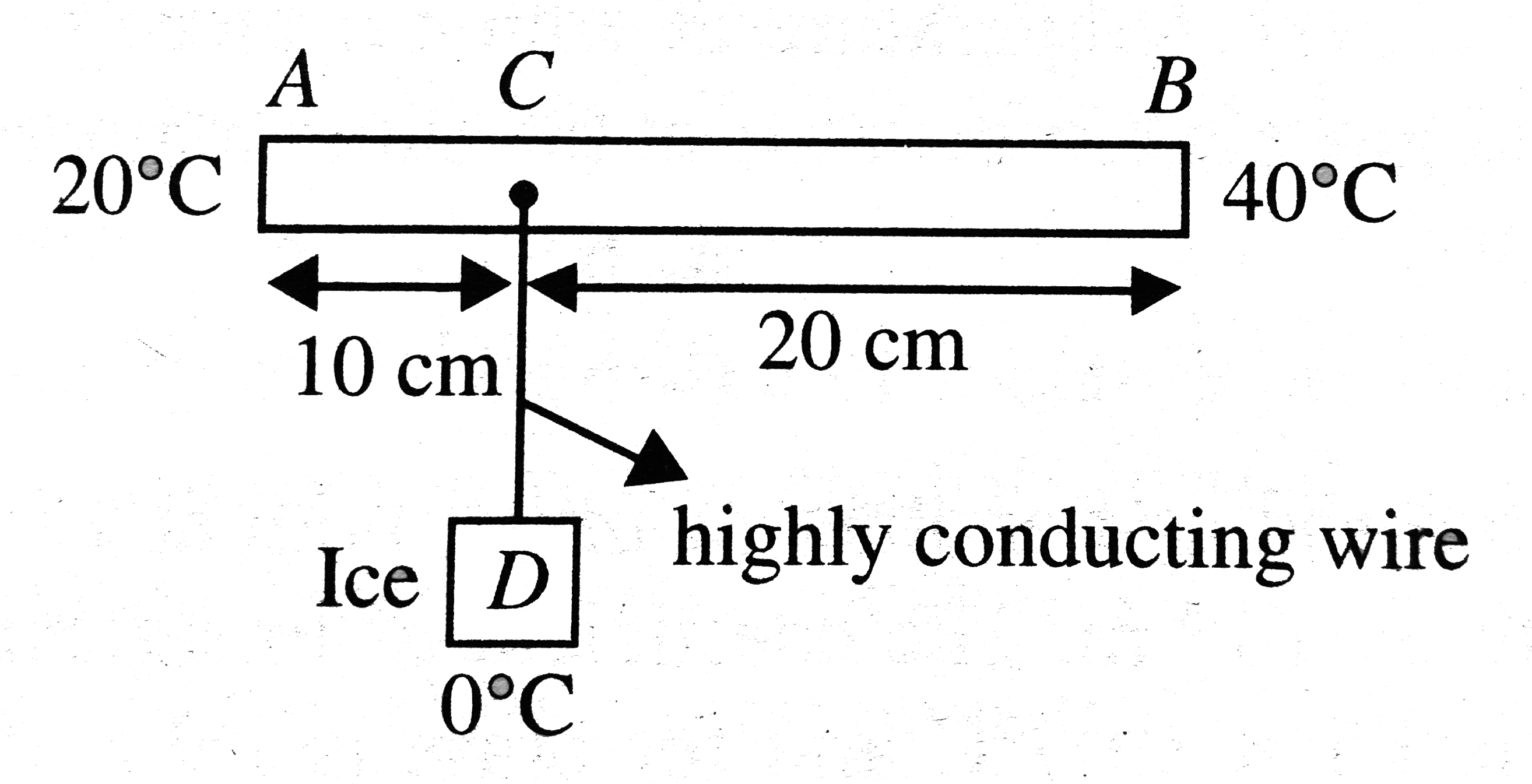
As shown in Fig. AB is rod of length 30 cm and area of cross section 1.0`cm^2` and thermal conductivity 336 SI units. The ends A and B are maintained at temperatures `20^@C` and `40^@C`, respectively .A point C of this rod is connected to a box D, containing ice at `0^@C` through a highly conducting wire of negligible heat capacity. The rate at which ice melts in the box is (assume latent heat of fusion for ice `L_f=80 cal//g`)
View SolutionTwo rods are joined between fixed supports as shown in the figure. Condition for no change in the length of individual rods with the increase of temperature will be
`"(" alpha_(1), alpha_(2)=` linear expansion coefficient
`A_(1), A_(2)=` Area of rods
`Y_(1), Y_(2)=` Young modulus `")"`
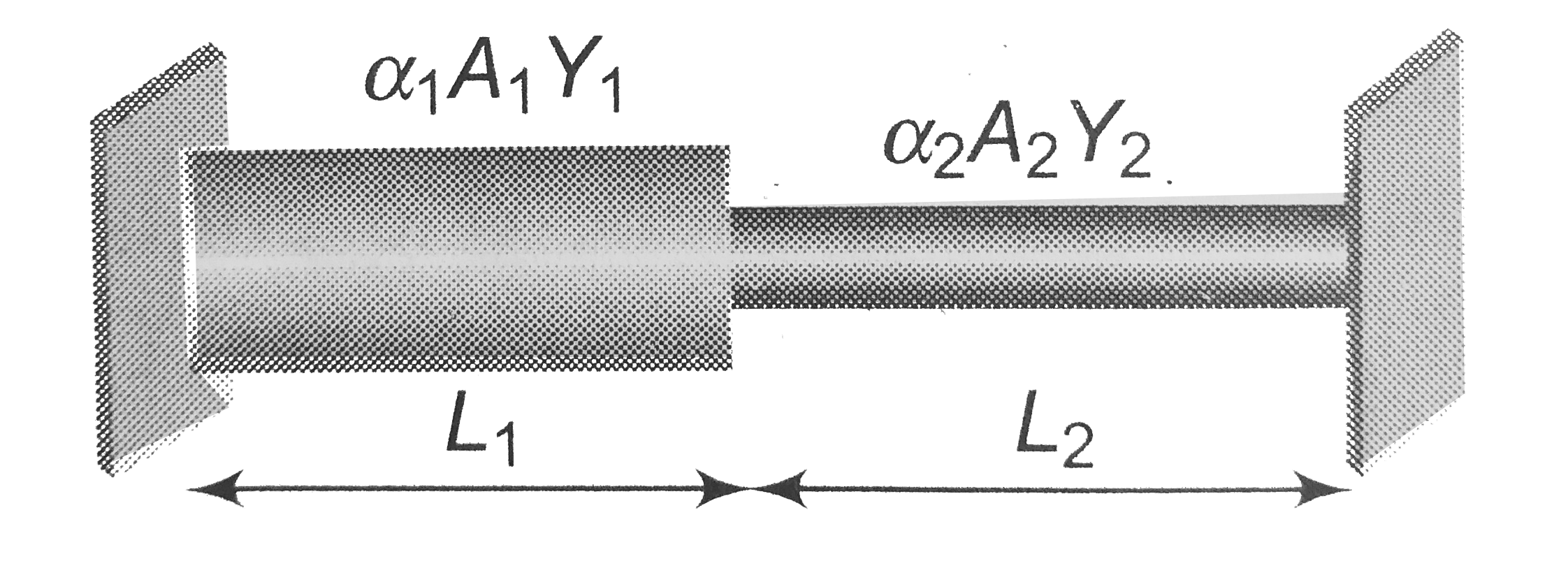
View SolutionA rod of length l and cross sectional area A has a variable conductivity given by `K=alphaT`, where `alpha` is a positive constant T is temperatures in Kelvin. Two ends of the rod are maintained at temperatures `T_1` and `T_2(T_1gtT_2)`. Heat current flowing through the rod will be
View SolutionA black body emits radiation at the rate P when its temperature is T. At this temperature the wavelength at which the radiation has maximum intensity is `lamda_0`, If at another temperature `T'` the power radiated is `P'` and wavelength at maximum intensity is `(lamda_0)/(2)` then
View SolutionA solid metallic sphere of diameter 20 cm and mass 10 kg is heated to a temperature of `327^@C` and suspended in a box in which a constant temperature of `27^@C` is maintained. Find the rate at which the temperature of the Sphere will fall with time. Stefan's constant`=5.67xx10^-8W//m^(2)//K^(4)` and specific heat of metal `=420J//kg//^(@)C`.
View SolutionThe coefficient of linear expansion of an in homogeneous rod change linearly from `alpha_(1)` to `alpha_(2)` from one end to the other end of the rod. The effective coefficient of linear expansion of rod is
View SolutionA wire is made by attaching two segments together end to end. One segment is made of aluminium and the other is steel. The effective coefficient of linear expansion of the two segment wire is `19xx10^(-6)//^(@)C`. The fraction length of aluminium is (linear coefficient of thermal expansion of aluminium and steel are `23xx10^(-6).^(@)C` and `12xx10^(-6)//^(@)C`,
View SolutionHeat is required to change 1 kg of ice at `-20^@C` into steam. `Q_1` is the heat needed to warm the ice from `-20^@C` to `0^@C`, `Q_2` is the heat needed to melt the ice, `Q_3` is the heat needed to warm the water from `0^@C` to `100^@C` and `Q_4` is the heat needed to vapourize the water. Then
View SolutionA block of wood is floating in water at `0^@ C`. The temperature of water is slowly raised from `0^@ C` to `10^@ C`. How will the precentage of volume of block above water level change with rise in temperature?
View SolutionAn incandescent lamp consumint `P=54W` is immersed into a transparent calorimeter containing `V=10^3cm^3` of water in 420 s the water is heated by `4^@C`. The percentage of the energy consumed by the lamp that passes out of the calorimeter in the form of radiant energy is
View SolutionA thread of liquid is in a uniform capillary tube of length L. As measured by a ruler. The temperature of the tube and thread of liquid is raised by `DeltaT`. If `gamma` be the coefficient of volume expansion of the liquid and `alpha` be the coefficient of linear expansion of the material of the tube, then the increase `DeltaL` in the length of the thread, again measured by the ruler will be
View SolutionA brass wire 2 m long at `27^@C` is held taut with negligible tension between two rigid supports. If the wire is cooled to a temperature of `-33^@C`, then the tension developed in the wire, its diameter being 2 mm, will be (coefficient of linear expansion of brass`=2.0xx10^(-5)//^(@)C` and Young's modulus of brass `=0.91xx10^(11)Pa`)
View SolutionA mass m of lead shot is placed at the bottom of a vertical cardboard cylinder that is 1.5 m long and closed at both ends. The cylinder is suddenly inverted so that the shot falls 1.5 m If this procces is repeated quickely 100 times, auuming no heat is dissipated or lost, the temperature of the shot will increase by (specific heat of lead`=0.03 cal//g^@C`)
View SolutionAn iron rocket fragment initially at `-100^@C` enters the earth's atmosphere almost horizontally and quickly fuses completely in atmospheric friction. Specific heat of iron is `0.11 kcal//kg^@C`. Its melting point is `1535^@C` and the latent heat of fusion is `3 kcals//kg`. The minimum velocity with which the fragmento must have entered the atmosphere is
View SolutionA liquid of density `0.85 g//cm^(3)` flows through a calorimeter at the rate of `8.0 cm^(2)//s`. Heat is added by means of a 250 W electric heating coil and a temperature difference of `15^@C` is established in steady state conditions between the inflow and the outflow points of the liquid. The specific heat for the liquid will be
View SolutionAn iron ball (coefficient of linear expansion`=1.2xx(10^(-5)//^(@)C`) has a diameter of 6 cm and is 0.010 mm too large to pass through a hole in a brass plate (coefficient of linear expansion`=1.9xx10^-5//^(@)C`) when the ball and the plate are both at a temperature of `30^@C` At what common temperature of the ball and the plate will the ball just pass through the hole in the plate ?
View SolutionA flask of mercury is sealed off at `20^@C` and is completely filled with mercury. If the bulk modulus for mercury is 250 Mpa and the coefficient of volume expansion of mercury is `1.82xx10^(-4)//^(@)C` and the expansion of glass is ignored, the pressure of mercury within flask at `100^@C` will be
View SolutionThe densities of wood and benzene at `0^(@)C` are `880 kg//m^(3)` and `900 kg//m^(3)` respectively. The coefficients of volume expansion are `1.2 xx 10^(-3)//'^(@)C` for wood and `1.5 xx 10^(-3)//'^(@)C` for benzene. At what temperature will a piece of wood just sink in benzene?
View SolutionAn iron rod and another of brass, both at `27^@C` differ in length by `10^-3`m. The coefficient of linear expansion for iron is `1.1xx10^(-5)//^(@)C` and for brass is `1.9xx10^(-5)//^(@)C`. The temperature at which both these rods will have the same length is
View SolutionAn ordinary refrigerator is thermally equivalent to a box of corkboard 90 mm thick and 5.6`m^2` in inner surface area. When the door is closed, the inside wall is kept, on the average, `22.2^@C` below the temperature of the outside wall. If the motor of the refrigerator runs `15%` of the time while the door is closed, at what rate must heat be taken from the interior whicle the motor is running?
The thermal conductivity of corkboard is `k=0.05 W//mK`.
View SolutionA bullet of mass 5 g moving at a speed of 200 m/s strikes a rigidly fixed wooden plank of thickness 0.2m normally and passes through it losing half of its kinetic energy. If it again strikes an identical rigidly fixed wooden plank and passes through it, assuming the same resistance in the two planks the ratio of the thermal energies produced in the two planks is
View Solution
A and B are tqo isolated spheres kept in close proximity so that they can exchange energy by radiation. The two spheres have identical physical dimensions but the surface of A behaves like a perfactly black body while the surface of B reflects `20%` of all the radiations it receives. They are isolated from all other sources of radiation.
View SolutionA thermally isulated piece of metal is heated under atmospheric pressure by an electric current so that it receives electric energy at a constant power P. This leads to an increase of absolute temperature T of the metal with time t as follows:
`T(t)=T_0[1+a(t-t_0)]^(1//4)`. Here, a, `t_0` and `T_0` are constants. The heat capacity `C_p(T)` of the metal is
View Solution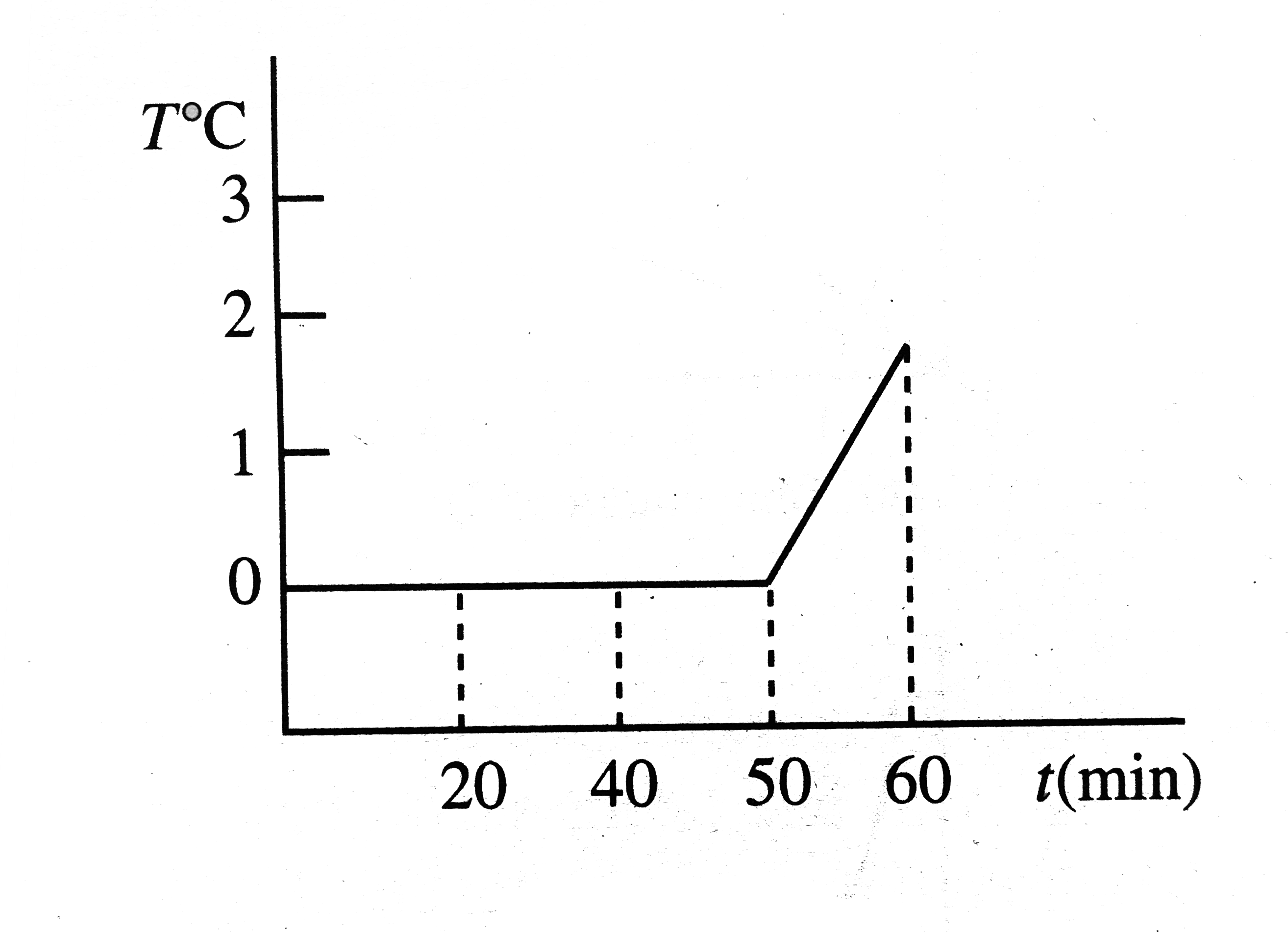
A cooking vessel on a slow burner contains 5 kg of water and an unknown mass of ice in equilibrium at `0^@C` at time `t=0`. The temperature of the mixture is measured at various times and the result is plotted as shown in Fig. During the first 50 min the mixture remains at `0^@C`. From 50 min to 60 min, the temperature increases to `2^@C` Neglecting the heat capacity of the vessel, the initial mass of the ice is
View SolutionA glass cylinder contains `m_0=100g` of mercury at a temperature of `t_0=0^@C`. When temperature becomes `t_1=20^@C` the cylinder contains `m_1=99.7g` of mercury The coefficient of volume expansion of mercury `gamma_(He)=18xx(10^(-5)//^(@)C` Assume that the temperature of the mercury is equal to that of the cylinder. The corfficient of linear expansion of glass `alpha` is
View SolutionPower radiated by a black body is `P_0` and the wavelength corresponding to maximum energy is around `lamda_0`, On changing the temperature of the black body, it was observed that the power radiated becames `(256)/(81)P_0`. The shift in wavelength corresponding to the maximum energy will be
View Solution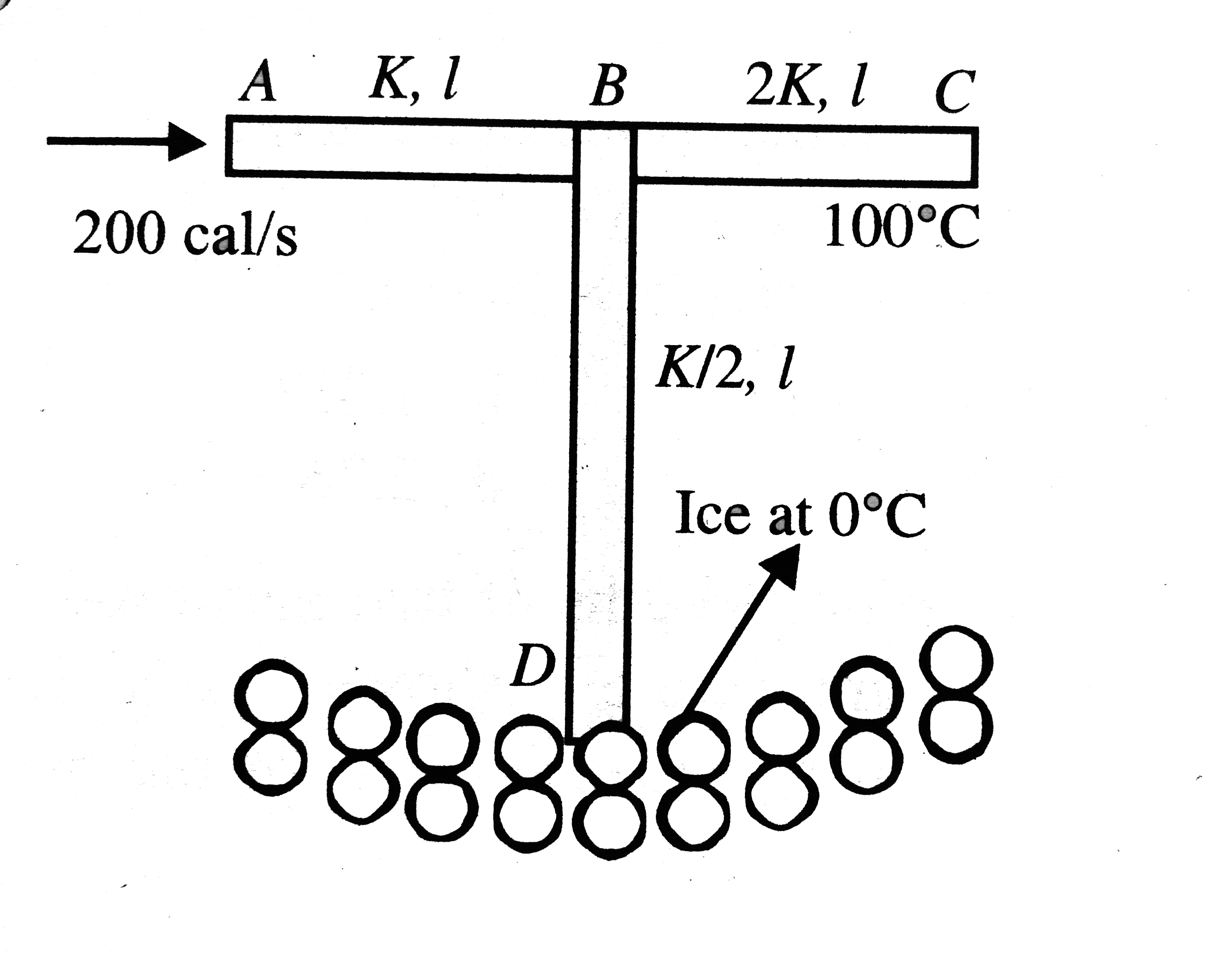
Three rods AB, BC and BD of same length l and cross section A are arranged as shown. The end D is immersed in ice whose mass is 440 g and is at `0^@C`. The end C is maintained at `100^@C`. Heat is supplied at constant rate of 200 cal/s. Thermal conductivities of AB, BC and BD are K, 2K and `K//2`, respectively Time after which whole ice will melt is (`K=100 cal//m-s^@C A=10cm^2,l=1cm`)
View SolutionThe length of s steel rod exceeds that of a brass rod by 5 cm. If the difference in their lengths remains same at all temperature, then the length of brass rod will be: (`alpha` for iron and brass are `12xx10^(-6)//^(@)C` and `18xx10^(-6)//^(@)C`, respectively)
View SolutionA container of capacity 700 mL is filled with two immiscible liquids of volume 200 mL and 500 mL with respective volume expansivities as `1.4xx10^-5//^(@)C` and `2.1xx10^(-5)//^(@)C`. During the heating of the vessel, it is observed that neither any liquid overflows nor any empty space is created. The volume expansivity of the container is
View SolutionThe apparent coefficient of expansion of a liquid when heated, filled in vessel A and B of identical volumes, is found to be `gamma_1` and `gamma_2`, respectively. If `alpha_1` be the linear expansivity of A then that of B will be
View SolutionA glass vessel is filled up to 3/5th of its volume by mercury. If the volume expansivities of glass and mercury be `9xx 10^(-6)//^(@)C` and `18xx10^(-5)//^(@)C` respectively, then the coefficient of apparent expansion of mercury is
View SolutionA thin circular metal disc of radius 500.0 mm is set rotating about a central axis normal to its plane. Upon raising its temperature gradually, the radius increases to 507.5 mm. The percentage change in the rotational kinetic energy will be
View SolutionA platinum sphere floats in mercury. Find the percentage change in the fraction of volume of sphere immersed in mercury whenthe temperature is raised by `80^@C` (volume expansivity of mercury is `182xxxx10^(-6)//^(@)C` and linear expansivity of platinum `9xx10^(-6)//^(@)C`)
View Solution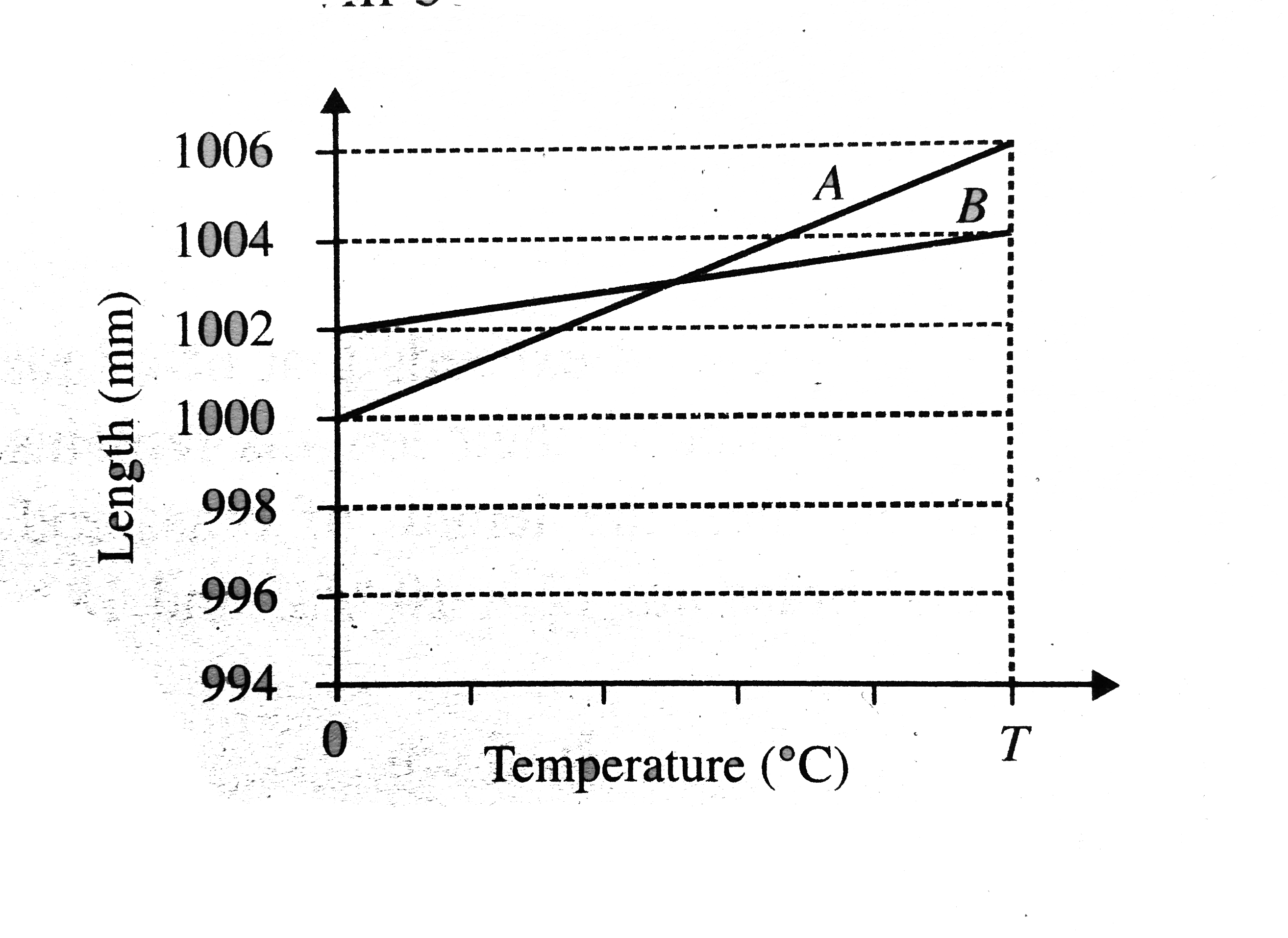
The variation of length of two metal rods A and B with change in temperature is shown in Fig. the coefficient of linear expansion `alpha_A` for the metal A and the temperature T will be
View Solution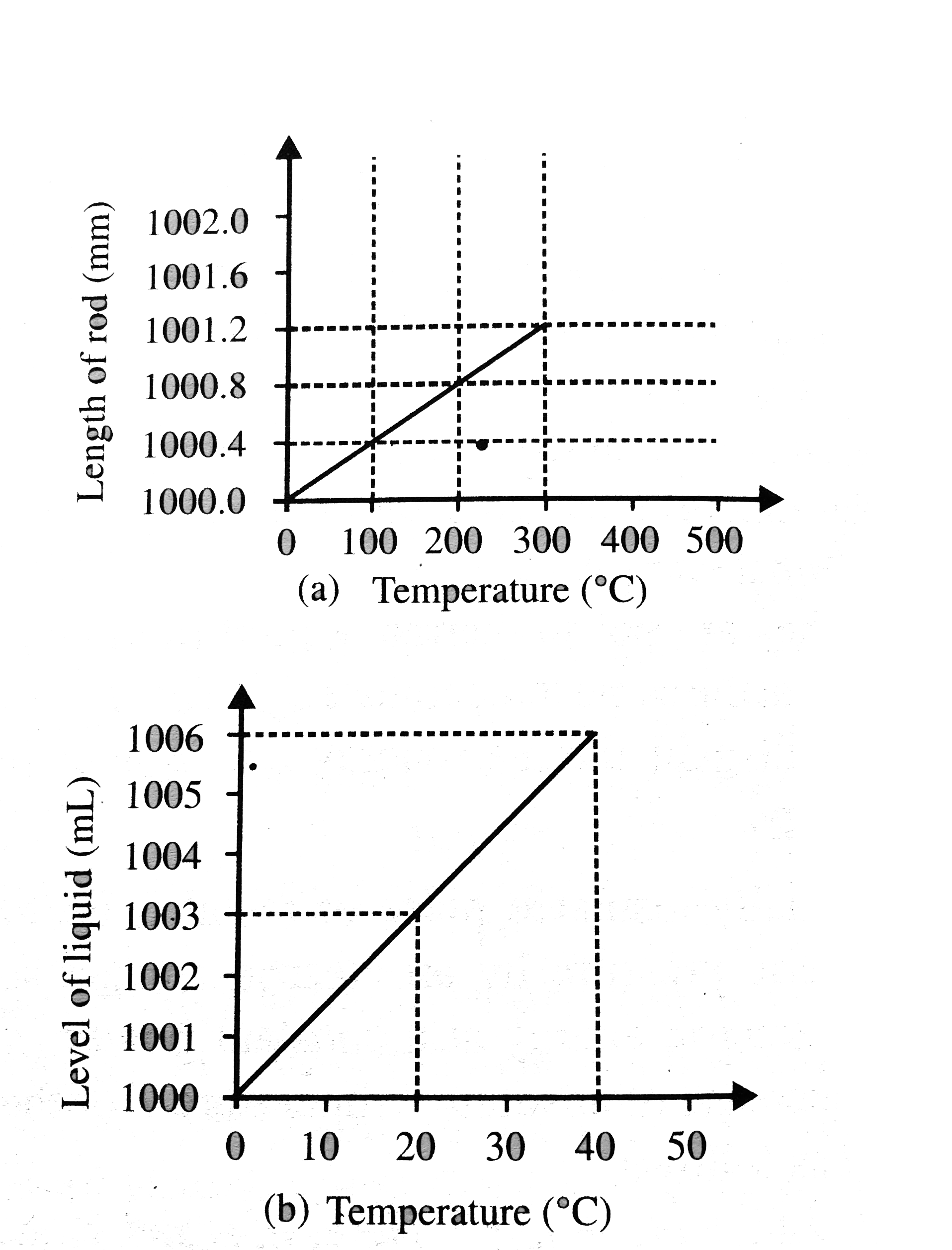
The graph of elongation of rod of a substance A with temperature rise is shown if Fig. A liquid B contained in a cylindrical cessel made up of substance A, graduated in millilitres at `0^@C` is heated gradually. The readings of the liquid level in the vessel corresponding to different temperatures are shown in the figure. the real volume expansivity of liquid is
View Solution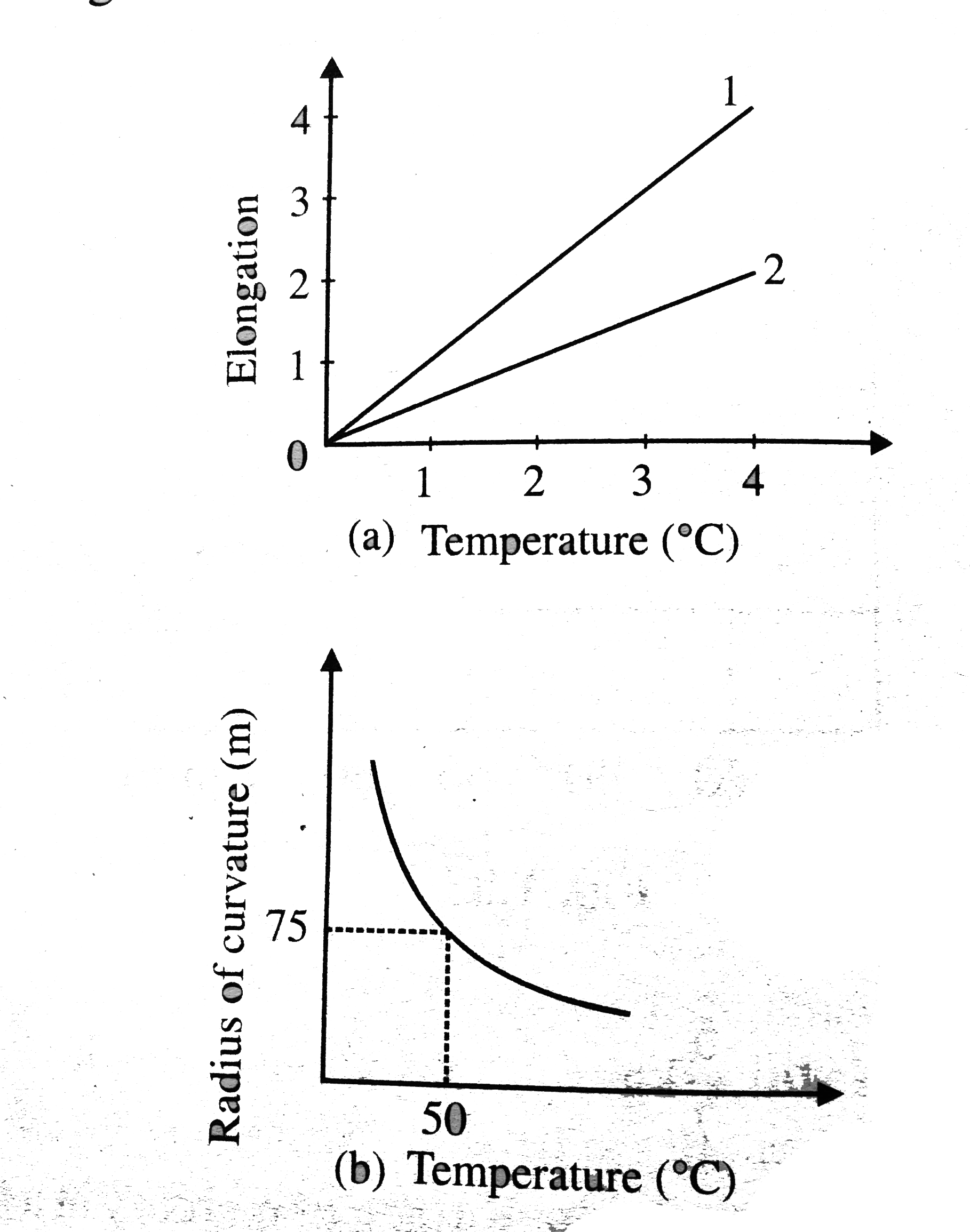
Figure. Shows the graphs of elongation versus temperature for two different metals. If these metals are employed to form a straight bimetallic strip of thickness 6 cm and heated, it bends in the form of an arc, the radius of cuvature chaging with temperature approximately as shown in the figure. The linear expansivities of the two metals are
View SolutionWater at `0^@C` contained in a closed vessel, is abruptly opened in an evacuated chamber. If the specific latent heats of fusion and vapourization at `0^@C` are in the ratio `lamda:1` the fraction of water eveporated will be
View SolutionA system receives heat continuously at the rate of 10 W. The temperature of the system becomes constant at `70^@C` when the temperature of the surroundings is `30^@C`. After the heater is switched off, the system cools from `50^@C` to `49.9^@C` in 1 min. The heat capacity of the system is
View SolutionIn a motor the electrical power input is 500 W and the mechanical power output is 0.54 horse power. Heat developed in the motor in 1 h is (assuming that all the electric energy which is not converted to mechanical energy is converted to heat) is
View SolutionThe molar heat capacity of a certain substance varies with temperature according to the given equation
`C=27.2+(4xx10^-3)T`
The heat necessary to change the temperature of 2 mol of the substance from 300 K to 700 K is
View SolutionThe corfficient of linear expansion for a certain metal varies with temperature as `alpha(T)`. If `L_0` is the initial elgnth of the metal and the temperature of metal is changed from `T_0` to `T(T_0gtT)`, then
View SolutionA piece of metal floats on mercury. The coefficients of volume expansion of the metal and mercury are `gamma_1` and `gamma_2` respectively. If the temperatures of both mercury and the metal are increased by an amount `DeltaT`, the fraction of the volume of the metal submerged in mercury changes by the factor............
View SolutionA uniform brass disc of radius a and mass m is set into spinning with angular speed `omega_0` about an axis passing through centre of disc and perpendicular to the palne of disc. If its temperature increases from `theta_1^@C` to `theta_2^@C` with out disturbing the disc, what will be its new angular speed ?
View SolutionCalculate the compressional force required to prevent the metallic rod of length l cm and cross sectional area `Acm^2` when heated through `t^@C` from expanding lengthwise. Young's modulus of elasticity of the metal is E and mean coefficient of linear expansion is `alpha` per degree celsius.
View SolutionThe coefficient of linear expansion of glass is `alpha_g` per `.^(@)C` and the cubical expansion of mercury is `lamda_m` per `.^(@)C`. The volume of the bulb of a mercury thermometer at `0^@C` is `V_0` and cross section of the capillary is `A_0`. What is the length of mercury column in capillary at `T^@C`, if the mercury just fills the bulb at `0^@C` ?
View SolutionA `10 kW` drilling machine is used to drill a bore in a small aluminium block of mass `8.0 kg`. How much is the rise in temperature of the block in `2.5` minutes, assuming `50%` of power is used up in heating the machine itself or lost to the surrounding? Specific heat of aluminium `= 0.91 J//g^(@)C`.
View SolutionA ball of thremal capacity `10 cal//^@C` is heated to the temperature of furnace it is then transferred into a vessel containing water. The water equivalent of vessel and the constents is 200 g. The temperature of the vessel and its contents rises from `10^@C` to `40^@C`. What is the temperature of furnace?
View SolutionTwo tanks A and B contain water at `30^@C` and `80^@C` respectively calculate the amount of water that must be taken from each tank respectively to prepare 40 kg of water at `50^@C`
View SolutionIt takes 10 in for an electric kettle to theat a certain quantity of water from `0^@C` to `100^@C`. It takes 54 min to convert this water `100^@C` into steam Then latent heat of steam is
View SolutionIce at `0^@C` is added to 200 g of water initially at `70^@C` in a vacuum flask. When 50 g of ice has been added and has all melted the temperature of the flask and contents is `40^@C`. When a further 80 g of ice has been added and has all melted the temperature of the whole becomes `10^@C`. Find the latent heat of fusion of ice.
View Solution
Single Correct questions and complete solutions for chapter CALORIMETRY of CENGAGE PHYSICS (HINGLISH) of Class 11